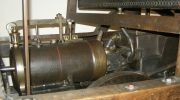Siegfried Marcus








Siegfried Marcus (1831-1898) was born in Malchin, Mecklenburg, in Germany.
Marcus was a prolific inventor, and produced a crude experimental vehicle which is claimed to be the first to be powered by a petrol engine. There is some uncertainty about its date, partly because relevant records were destroyed by the nazis, Marcus being of Jewish heritage. However, 1870 is considered to be the most likely date for this vehicle[1]
A later car, dated at 1888/9, is on display at Vienna Technical Museum. The car and its engine were made by Märky, Bromovsky & Schulz at their Adamstahl factory. [2].
For much more information, see Wikipedia entry
Vienna Technical Museum also has on display a compact internal combustion engine (described as a benzinmotor or petrol engine), dated c.1885. See photos. The frame casting originally bore the words PATENT S. MARCUS. WIEN, but an attempt has been made to chisel off WIEN (Vienna). For more information, see here.
1886 'A new petroleum engine, invented by the distinguished electrician, Herr Siegfried Marcus, of Nianna [Vienna!], is being supplied to the German navy for its torpedo boats. It is described as far more powerful than a steam engine of the same size, is less liable to derangement, and is not subject to explosions.'[3]

